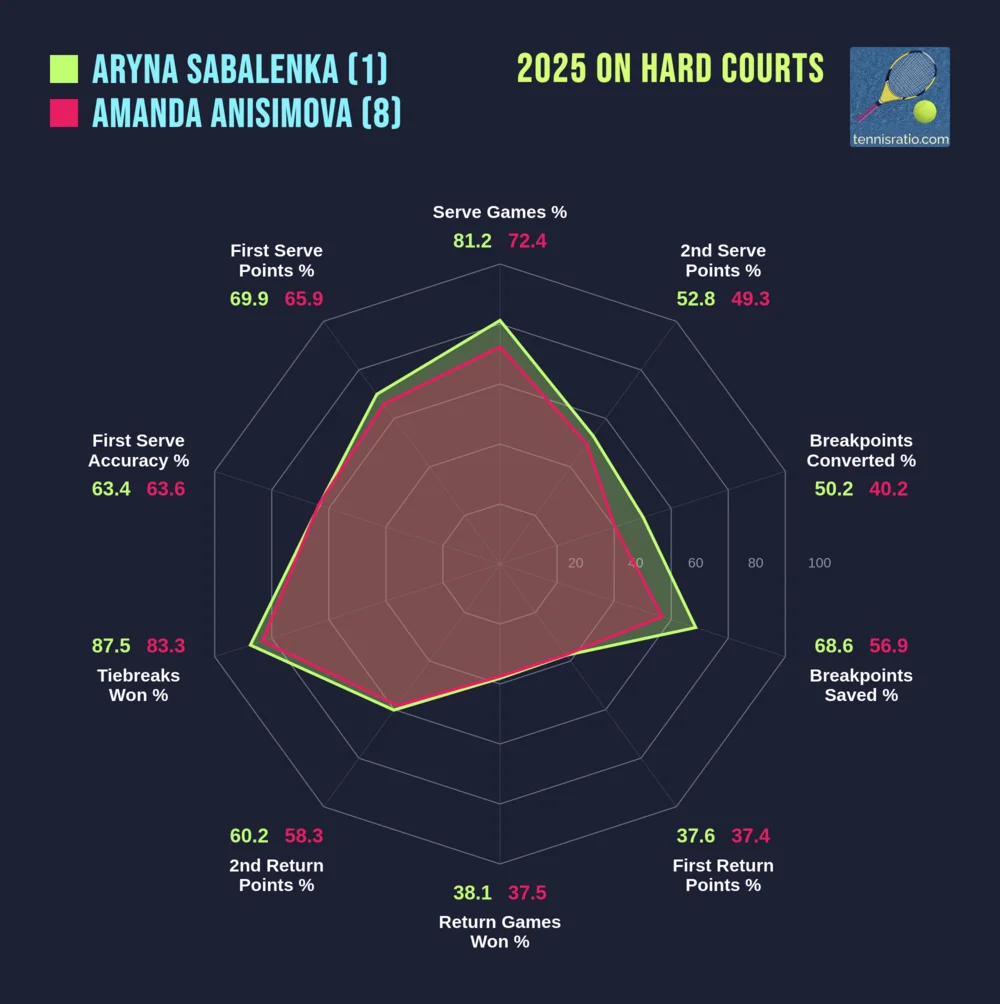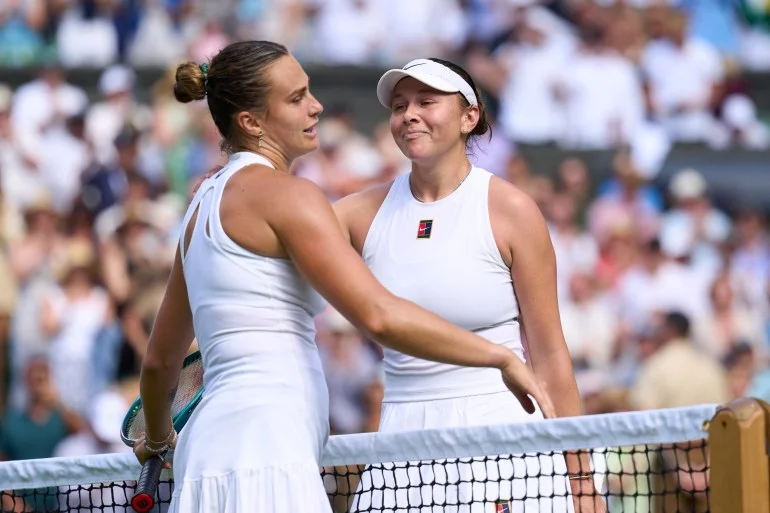The 2025 US Open women's final delivers a compelling narrative of contrasts: defending champion Aryna Sabalenka's quest for back-to-back titles meets Amanda Anisimova's journey of redemption, just 53 days after the American suffered the hurting double bagel defeat in the Wimbledon final. This championship match at Arthur Ashe Stadium on Saturday promises to showcase the raw power tennis that has defined both players' remarkable runs through Flushing Meadows, where neither has looked vulnerable until their dramatic three-set semifinal victories. Thursday's night at Arthur Ashe Stadium delivered two exciting three-setters where both the finalists needed to work hard for the place in the big final against their top class opponents.
Sabalenka vs. Pegula: Champion's Mettle on Display
Sabalenka's Rocky Start
The world No. 1 began her semifinal against Jessica Pegula in uncharacteristic fashion, surrendering the opening set 4-6 after leading 4-2. The American fourth seed displayed remarkable composure, breaking Sabalenka twice in succession to steal the first set with consecutive love holds. Sabalenka's usually reliable serve faltered at crucial moments, including a costly double fault that handed Pegula a 5-4 advantage. Pegula used her all rounder skills to gain control of the on-court events during the temporary slump of Sabalenka's level. The American scored just 6 winners in that set, but was super consistent with just 3 unforced errors recorded, which mostly granted her the first set on the scoreboard.
The Champion's Response
Sabalenka's response in the second set showcased why she sits atop the WTA rankings. The Belarusian immediately broke Pegula's serve and raced to a 4-1 lead, varying her tactics with more net approaches and softer touches that disrupted Pegula's rhythm. Her power game clicked into gear as she fired 15 winners in the set while reducing her error count. The 6-3 second set victory came in just 38 minutes, with Sabalenka winning 72% of her first-serve points and converting both break point opportunities.
Decisive quality in Third Set
The final set delivered the match's most compelling tennis, with Sabalenka breaking immediately but facing constant pressure from Pegula. The American created four break points but couldn't convert any, including two crucial chances at 3-2 that would have leveled the match. The champion needed three match points to close out the 4-6, 6-3, 6-4 victory, finishing with 43 winners to Pegula's 21 and maintaining her perfect record against the American in 2025 (now 8-2 overall head-to-head).
Anisimova vs. Osaka: Marathon Under the Lights
First Set Thriller
The second semifinal, which concluded at nearly 1 a.m. ET, began with both players struggling to hold serve - there were five breaks in the opening nine games. Osaka appeared in control after breaking Anisimova in the first game and racing to a 5-2 lead, but the American mounted a stunning comeback to level at 5-5. The tiebreak showcased both players' nerves, with Anisimova fighting back from 1-6 down before Osaka finally secured it 7-4 with a crucial forehand winner, converting the 4th setpoint. The set featured 26 winners combined but also 33 unforced errors, highlighting the strong hitting but high-risk nature of both players' games.
Second Set Momentum Swing
Anisimova's resilience shone through in the second set as she managed to force the decider despite losing the break advantage in second set three times. It was a shaky set from both, while the American was on the front foot in the scoreline since game one, Osaka chasing her back and there up to the 10th game when the Japanese denied Anisimova serving for the set. The tiebreak was needed once again, but looked opposite differently to the first one with the American's aggressive returning paid dividends as she jumped to a 5-1 lead in the tiebreak and held on to win it 7-3. Anisimova's backhand was particularly effective, producing 11 winners in the set alone while she improved her first-serve percentage from 55% in the opening set to 71%.
Anisimova's Breakthrough
The third set saw Anisimova maintain her composure while Osaka's level dropped noticeably. The American broke for a 3-1 lead with a stunning backhand passing shot and never looked back. She saved two break points while serving at 4-2 with consecutive aces, demonstrating the mental fortitude that had been missing in her Wimbledon final loss. The final game brought two breakpoints for Osaka, but Anisimova found her best on serve again to cross the finish line after long and quite dramatic last serving game. Her 6-7(4), 7-6(3), 6-3 victory extended Osaka's Grand Slam semifinal record to an imperfect 4-1, ending the Japanese star's remarkable tournament run. The match was as close in statistics as it looked like in first two sets. Anisimova produced 35 pressure points on return to Osaka's 36 with the simillar amount of efficiency during those moments. The world number 9 was on fire in decisive set, scoring excellent 16 winners in compare to just 9 errors - that occured to be the detail settling this exciting, high-performance tie from both.
Path to the Final: Statistical Dominance
Both finalists have demonstrated exceptional form throughout the fortnight. Sabalenka reached the final having played just four complete matches after Marketa Vondrousova's quarterfinal withdrawal, dropping only one set in the process. Pegula's match was definitely first serious test for Sabalenka, but she managed to pass it very well. The defending champion has fired 41 aces across the tournament, being lethal on serve. Sabalenka won 92.7% of her service games, 77% of her first-serve points and converted 48% of break point opportunities. Her 168 winners through five matches underscore the aggressive baseline game that has carried her to a third consecutive US Open final.
Anisimova's journey has been equally impressive with more challenges on the road, highlighted by her quarterfinal revenge victory over Iga Swiatek (6-4, 6-3) just weeks after losing 6-0, 6-0 in the Wimbledon final. The American's serving perfformance was impressive but not as impressive in numbers as her final opponent's. Anisimova dominated on return though, winning 43.3% return games (18% more than Sabalenka), 38.6% of first return and 60.8% of second return (10% and 4% more than Sabalenka respectively). She was breaking her opponents 28 times across six matches. Her 156 total winners and improving consistency (just 2.3 double faults per match) suggest she's peaking at the perfect moment.


The Championship Match Preview
Saturday's final presents a fascinating tactical battle between two of the WTA's biggest hitters. Anisimova leads their head-to-head by 6-3. The Belarusian needed some time to find the solution for Anisimova's gamestyle, scoring her first win in this rivarly after first 4 consecutive losses. The trend did not occur to change once for over though, as the American performed a significant upset in the semifinals of Wimbledon two months ago, ultimately denying the world number one to participate in all 4 major finals this year.
Anisimova enters as the clear crowd favorite, attempting to become the first American woman to win the US Open since Coco Gauff's 2023 triumph. Her serve will need to be more consistent than in the semifinal, and she must weather Sabalenka's inevitable power surges. The American's movement and court coverage have improved dramatically since their last meeting, and her newfound mental resilience - forged through her comeback from a mental health break in 2023 - could prove decisive in the pressure moments. The Belarusian must also manage the emotional momentum swings that have occasionally derailed her lately in big matches. Her experience edge is significant, playing in her 13th Grand Slam semifinal compared to Anisimova's third, and she'll be seeking to become the first woman since Serena Williams (2012-14) to win consecutive US Open titles. The pressure related to the world's number one spot is quite eased now after Iga Swiatek's defeat to Anisimova in quarterfinals, however Sabalenka is surely extremely determined to finish off the successful year without the drought in Grand Slam trophies collection.
